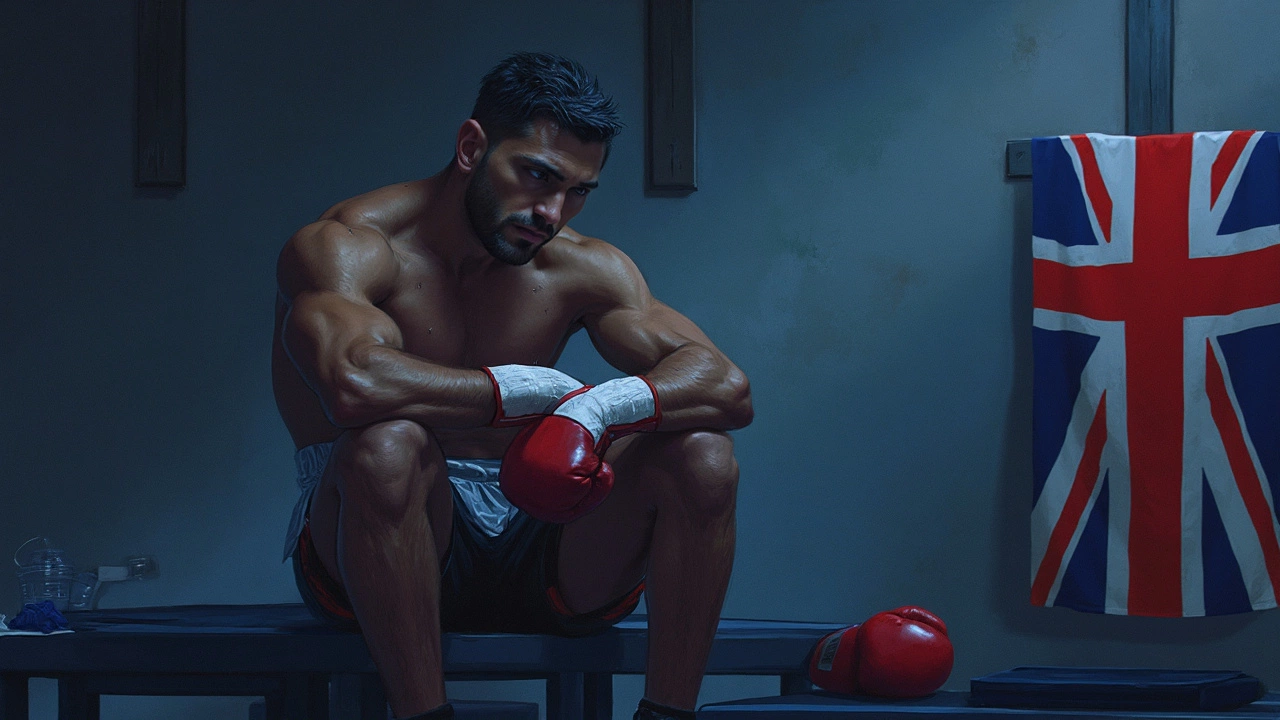Why Boxing is Tough: Real Challenges in the Ring
 Mar, 23 2025
Mar, 23 2025
Boxing is a whole-body workout that takes a toll on even the toughest athletes. Ever wonder why boxers look exhausted within a few rounds? It's more than just swinging arms. Boxing demands a rare blend of cardio, strength, and endurance. Imagine exercising every muscle group while staying quick on your feet. That's just the start.
But boxing isn't just a physical feat; it's a chess game at high speed. Boxers constantly think on their feet, adapting strategies, and reading opponents. It's about anticipating moves and using wit to win. The brain's quick decisions amidst fatigue are what really sets apart the amateurs from the pros.
- Physical Demands of Boxing
- Mental Toughness and Strategy
- Training Routines
- Endurance and Recovery
- Real-Life Stories from the Ring
Physical Demands of Boxing
Boxing looks tough because it is. The physical demands on a boxer's body are like running a marathon while playing chess. You've got to move, punch, block, and think all at once. And let's not forget, each punch demands explosive power while you manage to dodge incoming hits.
Endurance is often underestimated in boxing. It's not just a few rounds of swinging. A match can last up to 12 rounds, each three minutes long, with just a minute break in between. Yeah, just sixty seconds to catch your breath, regroup mentally, and listen to your coach.
Strength and Power
Every punch isn't just about arm strength; it demands full-body coordination. Starting from your feet, through your knees, hips, and torso, the power builds up. This is why boxers spend hours working on drills that enhance muscle coordination and increase power—not just for hitting hard but for defending and moving efficiently.
Cardiovascular Fitness
You'd be wrong if you think cardio workouts are just for runners. In boxing, heart and lung capacity play huge roles. Think about training that involves intense skipping, running, and sparring—working on cardiovascular fitness so boxers don’t tire out early right in the middle of that ring.
The training aims to mimic a real fight's intensity, keeping the heart rate high. You need heart and lungs that can take a pounding just like any fighter.
Coordination and Agility
It's not all about throwing wild punches. Precision and timing can win the fight. Boxers work on agility with footwork drills, shuffles, and shadowboxing. You'll see them dancing around the ring, which requires insane levels of coordination. Quick on their feet, but always staying balanced. It’s all about those quick transitions.
All these physical demands aren't just for the pros; even beginners experience them during training. If you're ever keen to try boxing, expect a full-body workout like no other! And remember, mastering the balance between strength, endurance, and technique is key to stepping into the ring ready for action.
Mental Toughness and Strategy
In boxing, having the physical strength is just half the battle. The mental game is where champions are made. You need the resilience to keep going even when your body screams to stop. Imagine being punched repeatedly and still having the clarity to stay focused and strategize. That's no small feat.
One big part of mental toughness is handling fear and stress. Boxers train to stay calm under pressure, even when the stakes are high. It's about mastering emotions and not letting them interfere with decision-making. Can you keep your cool when faced with adversity? That's a boxer’s everyday challenge.
Reading and Reacting
A big part of boxing is reading your opponent's next move before they make it. Think of it like a high-speed game of chess where hesitation can cost you. Boxers are trained to spot tiny cues, like shifts in weight or quick glances, to predict what's coming next. Mastering this art requires intense focus and experience.
The Strategy Game
Every fight is unique, requiring a different strategy. While some matches might need quick jabs and swift footwork, others demand powerful hooks and uppercuts. Around 70% of professional boxers spend time analyzing their opponents’ past fights, looking for patterns and weaknesses to exploit. Strategy isn't just about offense — great defense is just as crucial.
Let's not forget the corner team. Boxers rely on their coaches during matches to provide strategic advice and emotional support. They help adjust tactics mid-fight, aiming to exploit any arising opportunities.
The mental aspect of boxing, combined with the strategic dimension, is why even the fittest athletes may not last a full bout. Next time you watch a match, think about the mental gymnastics happening inside the ring. It's a contest of wits just as much as physical prowess.

Training Routines
Boxers put in a ton of work behind the scenes. Anyone who's ever stepped into a boxing gym knows there's more to training than jabs and crosses. A typical routine focuses on building endurance, strength, and agility—key components for lasting through intense bouts.
Warm-Ups
Every session starts with a good warm-up. It's like greasing the wheels before making that engine rev. Jump roping is common; it builds footwork and keeps you light on your toes. And of course, shadow boxing—great for practicing technique solo.
Strength and Conditioning
Strength training's a must. Who cares about lifting nice numbers when you're in the middle of a fight and need that explosive power? Boxers hit the weights to strengthen muscles, focusing on core exercises like squats, deadlifts, and bench presses. They're not just building their biceps; they're gearing up to deliver some real knockout punches.
A typical day might look like this:
- Morning: Cardio, usually running 3-5 miles
- Midday: Sparring rounds and technique drills
- Evening: Weights or circuit training
Technique and Sparring
Technique work's like the bread and butter of boxing. Footwork drills, mitt work, and sparring sessions hone a fighter's skillset. Sparring in particular is crucial; it gets boxers used to taking and deflecting hits. Benny Leonard, old-time boxing great, once said, "The more you sweat in practice, the less you bleed in battle."
Rest and Recovery
No one can go full throttle all the time. Recovery days are just as important. They mix up rest with active recovery like yoga or swimming to keep the body moving.
Numbers and Stats
| Component | Average Weekly Hours |
|---|---|
| Cardio & Conditioning | 10-12 |
| Strength Training | 5-6 |
| Sparring & Technique | 8-10 |
It's no walk in the park. Training is intense, structured, and relentless. That endurance and toughness you see in the ring? It starts right here, in the gym, day in and day out.
Endurance and Recovery
Endurance in boxing isn't just about lasting longer in a match; it's about maintaining power and technique even when you're gassed out. This is where dedicated cardio training comes into play. Boxers often incorporate long runs, sprints, and interval training into their routine to build that necessary stamina.
Efficient Endurance Training
Cardio workouts are a staple in a boxer's regimen. We’re talking about roadwork—running several miles a day, mixing it up with high-intensity interval training. This mix helps maximize heart efficiency and keeps the muscles oxygenated during those intense rounds.
The Importance of Recovery
After all that hard work, recovery becomes crucial. Without it, even the strongest athletes can burn out. Recovery isn't just about rest; it's active. Techniques include stretching, yoga, and those strange-looking foam rollers. These help reduce muscle stiffness and prevent injuries.
Nutrition also plays a huge role. Boxers need to nourish their bodies with a balance of proteins, carbs, and fats to repair and build muscle. Hydration is just as important—keeping the muscles functioning and preventing cramps.
Understanding the Cycle
Building endurance and ensuring recovery form a cycle. Skipping out on recovery can lead to overtraining, fatigue, and injuries, cutting short any plans to become a champ. So, it's all about finding the right balance.
| Training Element | Description |
|---|---|
| Cardio | Running, biking, or swimming to boost stamina. |
| Strength Training | Weightlifting to enhance power and muscle resistance. |
| Recovery | Stretching, yoga, and proper nutrition/hydration. |

Real-Life Stories from the Ring
Dive into the stories of those who’ve sweated, bled, and triumphed in the boxing ring. One iconic tale is that of Muhammad Ali, who was not only known for his powerful punches but also for his mental agility. Remember the "Rumble in the Jungle"? Ali faced George Foreman, a guy nobody thought he could beat. Ali used his famous 'rope-a-dope' strategy, letting Foreman tire himself out, and then took him down. That was a classic mix of strategy and physical endurance.
Another gripping story is about Micky Ward, whose life was a testament to grit and perseverance. His trilogy of fights with Arturo Gatti is legendary. These bouts weren’t just about who hit harder—they were about who could endure more. Ward took punishment, but his ability to stay in the fight and keep pushing forward made those matches a part of boxing folklore.
The Underdogs
Speaking of unexpected triumphs, Andy Ruiz Jr. shocked the world in 2019. He wasn't even on most people's radars when he knocked out Anthony Joshua to become the first Mexican-American heavyweight champion. Ruiz wasn’t the typical heavyweight; he didn’t have the chiseled physique you’d expect. But he showed the world that sometimes heart matters more than appearance.
Endurance often tells the untold stories in the ring. Collins, who was once on the verge of retirement due to a poor record, revived his career by defeating the then-unbeatable Chris Eubank in the mid-90s. Defying all odds, he was proof that mental toughness is just as crucial as physical prowess.